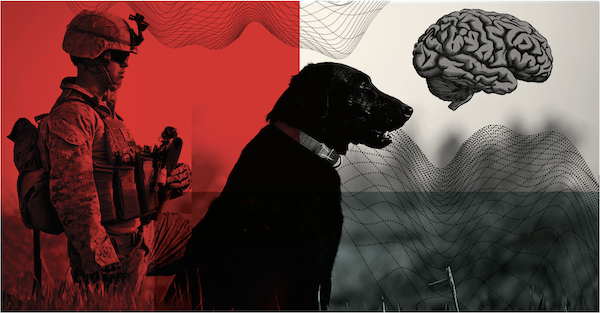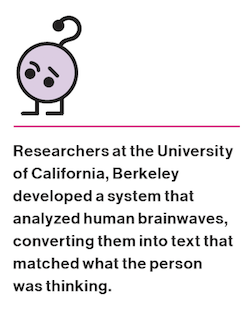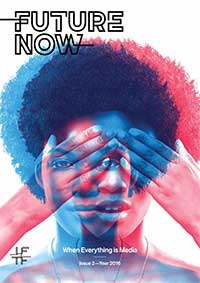Future Now
The IFTF Blog
From Domestication to Amplification
How networked animals are becoming our new collaborators
Technology has transformed our relationships with animals. Horses were once the “motors” for long-distance transport, but are now mainly pets for people who can afford them. And you can still find oxen pulling plows in third-world countries, but they’ve been replaced by tractors everywhere else. With few exceptions, machines have supplanted work animals. Nowadays, people in urban areas rarely encounter animal collaborators, the exceptions being police, security, and service dogs.
But this appears to be changing. In her widely cited paper aimed at establishing the field of Animal Computer Interaction, Clara Mancini, an interaction design lecturer at the Open University in the United Kingdom, argues that simultaneous advances in cognitive and computer sciences are opening up opportunities to pinpoint unique forms of animal intelligence, and that we will develop interfaces for animals to interact with complex computational systems. As we look to the next decade, in which we embed computational power everywhere and into everything, we will rethink when, where, and how we collaborate with animals. While we are unlikely to encounter amplified animals in knowledge work, they will emerge in other fields ranging from healthcare to advertising.
These early signals of animal computer interaction highlight the new ways that technologically amplified animals will become new kinds of collaborators.
Dogs that deliver telepresence robots: Search and rescue dogs are much more agile and capable of negotiating disaster locations than humans, and have been used for centuries to aid in rescue missions. Teams at Carnegie Mellon University and Ryerson University worked together to further boost the capacities of disaster-relief dogs by equipping them with a remote-controlled robotic snake, which houses a video camera so rescuers can investigate a hard-to-reach scene. The true novelty here lies in the fact that the snake—which is attached to the dog’s body—drops to the ground automatically when the dog barks, which it is trained to do upon smelling a human in need of rescue.

Bees trained to detect diabetes: Bees have a sense of smell 10 million times more acute than a human’s. They can be trained to detect the smell of acetone, a chemical more plentiful in the breath of people with diabetes. Specialists at the Joslin Diabetes Center in Boston have made a small portable device to house bees trained to stick their tongues out in the presence of acetone. The bees are, in essence, being used as both sensor and interface in a new kind of machine that taps the unique aptitude of bees to empower health researchers.
Wardriving felines: A roaming cat in Washington, D.C. wears an experimental smart collar that monitors and maps local WiFi networks to find vulnerable and exposed networks. Presented at DefCon hacker conference in Las Vegas, the project represented more of a novelty than a new security risk or hacker opportunity. However, this is one more good example of technology being paired with the unique abilities of an animal (in this case, the sneakiness of cats) to accomplish a task neither the technology nor the animal could accomplish alone.
 Pigeon smog reporters: A flock of racing pigeons in London was outfitted with tiny air-pollution detection backpacks for a three-day experiment in monitoring urban health. People received smog level reports on Twitter at @pigeonair, accessing the data almost 40,000 times. The makers of the pigeon backpacks are now offering bicyclists and other people similar mini air-detection devices.
Pigeon smog reporters: A flock of racing pigeons in London was outfitted with tiny air-pollution detection backpacks for a three-day experiment in monitoring urban health. People received smog level reports on Twitter at @pigeonair, accessing the data almost 40,000 times. The makers of the pigeon backpacks are now offering bicyclists and other people similar mini air-detection devices.
Talking dogs: At the intersection of EEG sensors, micro-computing, and brain-computer interfaces lies No More Woof, an experimental technology to detect and interpret what’s on your dog’s mind and play canned phrases like, “I’m hungry—but I don’t like this!” or, “I’m curious who that is,” through a loudspeaker. (If you’ve seen the Pixar movie, “Up,” you’ll recognize this technology, which served as the inspiration for No More Woof.) Developed by Nordic Society for Innovation, the project raised over $22,000 US on Indiegogo. The developers acknowledge there is much basic research left to complete before No More Woof hits the shelves.
Bomb-detecting dolphins: The military was using dolphins to detect underwater objects as early as 1959, but new efforts are far more rigorous and involve more extensive training for the dolphins. Six trained dolphins that were part of the U.S. Navy Marine Mammal Program (which also trains sea lions) were deployed off the coast of Croatia in 2013 to detect unexploded ordnance and other dangerous military elements. The dolphins carefully mark the location of these hazards so that human divers can dispose of them appropriately.
Washing machine for dogs: While service dogs have been trained to strip beds, fill laundry baskets, and accomplish many other pivotal household tasks, they encounter difficulty using machines. Woof to Wash is a service-dog-friendly washing machine from appliance maker JTM Service. The washing machine turns on when it detects a bark, and has a door-opening button set within paw’s reach, so that the service dog can unload it. Only one prototype of Woof to Wash exists, but it hints at the important challenges and opportunities that come from empowering service dogs to help their owners live independently in our technology-driven world.
 FUTURE NOW—When Everything is Media
FUTURE NOW—When Everything is Media
In this second volume of Future Now, IFTF's print magazine powered by our Future 50 partnership, we explore the future of communications, tracing historical technology shifts through the present and focusing on the question: “What is beyond social media?”
Think of Future Now as a book of provocations; it reflects the curiosity and diversity of futures thinking across IFTF and our network of collaborators. This issue contains expert interviews, profiles and analyses of what today’s technologies tell us about the next decade, as well as comics and science fiction stories that help us imagine what 2026 (and beyond) might look and feel like.
About IFTF's Future 50
Every successful strategy begins with an insight about the future. Every organization needs to build the capacity to anticipate the future. The Future 50 is a side-by-side relationship with Institute for the Future; it’s a partnership focused on strategic foresight on a ten-year time horizon. With 50 years of futures research in society, technology, health, the economy, and the environment, IFTF has the perspectives, networks, signals, and tools to make sense out of the emerging future.
For More Information
For more information on IFTF's Future 50 Partnership and Tech Futures Lab, contact:
Sean Ness | sness@iftf.org | 650.233.9517



